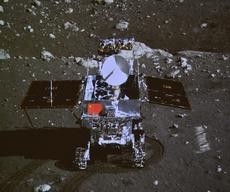Chang'e 5, China's New Moon Mission, is on Track for 2017 Landing
| dweisman | | Jul 29, 2014 02:13 AM EDT |
(Photo : REUTERS/Stringer ) A photograph of the giant screen at the Beijing Aerospace Control Center shows photo of the Yutu, or "Jade Rabbit" lunar rover taken by the camera on the Chang'e 3 probe during the mutual-photograph process, in Beijing December 15, 2013.
China hopes to become the second nation to send humans to the moon, but first must settle for lunar probes, including a 2017 Chang'e 5 rover mission aimed at returning lunar samples to Earth.
Development of China's Chang'e 5 lander and Yutu, or "Jade Rabbit" rover mission to the moon continues on course, according to Chinese space officials.
Like Us on Facebook
Officials, however, cautioned they first have to deal with mechanical problems found in China's previous Chang'e 3 lunar mission last year. They are confident of success.
The Chang'e 5 mission extends the nation's space program beyond Chang'e 3, which successfully placed a lander and rover on the moon last December 14.
"The development of Chang'e 5 is proceeding smoothly," said Wu Zhijian, a China State Administration of Science and Technology and Industry spokesman.
"The program's third phase will be more difficult because many breakthroughs must be made in key technologies, such as moon surface takeoff, sampling encapsulation, rendezvous and docking in lunar orbit, and high-speed Earth re-entry."
The Chang'e 4 backup probe for Chang'e 3 will be used for Change'e 5 and Chang'e 6 lunar missions. Despite China's progress in space exploration, Wu noted China lagged behind the United States and Russia in the spacerace.
Hu Hao, lead designer for the lunar exploration's program sample-return mission, said experimental tests proved Chang'e 5 can perform the mission successfully.
The spacecraft's two modules are designed to separate. One module was designed to scoop lunar soil, placing soil into a mini-module that will blast away from the moon and dock with the orbiting module. It's called a "relay" approach.
Some lunar soil will be picked up directly from the lunar surface, while other lunar samples will be scooped up from a depth of 2 meters, or 6-2/3 feet. A potential lunar landing site had yet to be chosen, but much care will go into that process, officials said.
Scientists believe potential sites should have features like recent lava flows or fresh craters from recent lunar impacts. Suggested sites included Flamsteed P with the youngest lunar lava flows, the floor of the Copernicus crater or Sinus Aestuum with dark, deep-origin mantle deposits.
China's first spacecraft, the Chang'e 1, launched in 2007. The Chang'e 2 asteroid blasted off Oct. 1, 2010 and continues hurtling through space about 70 million kilometers from the Forbidden City.
TagsChang'e mission, China space program, lunar landings, Science, NASA
©2015 Chinatopix All rights reserved. Do not reproduce without permission
EDITOR'S PICKS
-

Did the Trump administration just announce plans for a trade war with ‘hostile’ China and Russia?
-

US Senate passes Taiwan travel bill slammed by China
-

As Yan Sihong’s family grieves, here are other Chinese students who went missing abroad. Some have never been found
-

Beijing blasts Western critics who ‘smear China’ with the term sharp power
-

China Envoy Seeks to Defuse Tensions With U.S. as a Trade War Brews
-

Singapore's Deputy PM Provides Bitcoin Vote of Confidence Amid China's Blanket Bans
-

China warns investors over risks in overseas virtual currency trading
-

Chinese government most trustworthy: survey
-

Kashima Antlers On Course For Back-To-Back Titles
MOST POPULAR
LATEST NEWS
Zhou Yongkang: China's Former Security Chief Sentenced to Life in Prison

China's former Chief of the Ministry of Public Security, Zhou Yongkang, has been given a life sentence after he was found guilty of abusing his office, bribery and deliberately ... Full Article
TRENDING STORY

China Pork Prices Expected to Stabilize As The Supplies Recover

Elephone P9000 Smartphone is now on Sale on Amazon India

There's a Big Chance Cliffhangers Won't Still Be Resolved When Grey's Anatomy Season 13 Returns

Supreme Court Ruled on Samsung vs Apple Dispute for Patent Infringement

Microsoft Surface Pro 5 Rumors and Release Date: What is the Latest?










